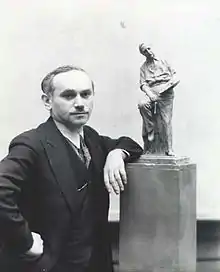Max Kalish | |
|---|---|
 | |
| Born | March 1, 1891 |
| Died | 1945 (aged 53–54) |
| Occupation | sculptor |
| Notable work | statue of Abraham Lincoln in Cleveland, Ohio |
Max Kalish (March 1, 1891 – 1945) was American sculptor born in Valozhyn, Belarus, and best known for his sculptures of laborers.
His Orthodox Jewish family emigrated to Cleveland, Ohio in 1893, when he was two years old.[1]
He studied with Herman Matzen at the Cleveland School of Art; in New York City with Herbert Adams at the National Academy of Design, and in the studios of Alexander Stirling Calder and Isidore Konti; and in Paris with Paul Wayland Bartlett at the Académie Colorossi, and Jean Antoine Injalbert at the École des Beaux-Arts.[2][3][1]
A travelling exhibition of his work, titled "Glorification of the U.S. Workingman", stopped in Detroit in January 1927.[4]
Washington, D.C. publisher Willard M. Kiplinger commissioned Kalish to create fifty portrait statuettes of prominent figures in World War II era politics, arts and sciences. Kiplinger donated the statuettes to the Smithsonian Institution in 1944.[5]
Kalish was the author of Labor Sculpture, largely a collection of photographs of these statues of workers. Most of those statutes were in a Social realism style. Critic Emily Genauer wrote in 1938, "It is the workmen who dominate the American scene, and who have become as surely symbolic of their time as the pioneers in covered wagons, and the robber barons and the great merchant princes were in their respective eras." This was what Kalish portrayed in his art.[6]
Works
Examples of Kalish's work can be found in:[7]
- Baby’s Head, Canajoharie Library and Art Gallery, Canajoharie, New York
- Old Man Resting, Massillon Museum, Massillon, Ohio
- Portrait of a Boy, North Carolina Museum of Art, Raleigh, North Carolina
- Gold Prospector, Canton Museum of Art, Canton, Ohio
- Head of Louis Kronberg, Museum of Fine Arts, Boston, Massachusetts
- Torso, Washington County Museum of Fine Arts, Hagerstown, Maryland
- Laborer at Rest, Newark Museum, Newark, New Jersey
- Torso (1925), Cleveland Museum of Art, Cleveland, Ohio
- Woodcutter (c1926)[8]
- The Steelworker (c1926)[8]
- The Discard (c1926)[8]
- Spirit of American Labor (c1927)[8]
- New Power[4]
- The End of Day (1930), Smithsonian American Art Museum, Washington, D.C.
- Abraham Lincoln (1927–32), Board of Education, Cleveland, Ohio
- Man of Steel (before 1933), Smithsonian American Art Museum, Washington, D.C.
 The End of Day (1930), Smithsonian American Art Museum.
The End of Day (1930), Smithsonian American Art Museum. Abraham Lincoln (1927–32), Cleveland Municipal School District Headquarters.
Abraham Lincoln (1927–32), Cleveland Municipal School District Headquarters. Man of Steel (before 1933), Smithsonian American Art Museum.
Man of Steel (before 1933), Smithsonian American Art Museum.
References
- 1 2 "Max Kalish | Smithsonian American Art Museum".
- ↑ Opitz, Glenn B, editor, Mantle Fielding's Dictionary of American Painters, Sculptors & Engravers, Apollo Book, Poughkeepsie NY, 1986
- ↑ McGlauflin, Alice Coe, editor, Who’s Who in American Art 1938-1939, vol. 2, The American Federation of Arts, Washington D.C., 1937
- 1 2 "Art: In Detroit". Time. January 31, 1927. ISSN 0040-781X. Retrieved January 16, 2023.
- ↑ Walter Lippmann, from Smithsonian Institution.
- ↑ Kalish, Max, Labor Sculpture, Introduction by Emily Genauer, New York, 1938, copyright by Max Kalish, introduction
- ↑ "SIRIS - Smithsonian Institution Research Information System".
- 1 2 3 4 Dabakis, Melissa (1986). "The Individual vs. the Collective: Images of the American Worker in the 1920s". IA. The Journal of the Society for Industrial Archeology. 12 (2): 51–62. ISSN 0160-1040. JSTOR 40968110.
Further reading
- Labor Sculpture by Max Kalish, A. N. A. Emily Genauer, editor. New York: Cornet Press, 1938.
- The Sculpture of Max Kalish. Noel Lawson Lewis, author. Cleveland: Fine Arts Pub. Co., 1933.